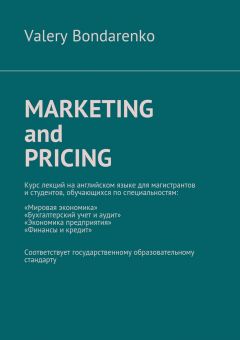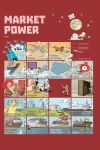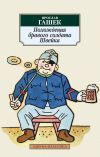Текст книги "Marketing and Pricing"

Автор книги: Valery Bondarenko
Жанр: Прочая образовательная литература, Наука и Образование
Возрастные ограничения: +12
сообщить о неприемлемом содержимом
Текущая страница: 2 (всего у книги 7 страниц)
Market research presupposes the collection and analysis of data on specific marketing situations with which the company has faced in the market. Such activities are carried out periodically, rather than continuously, as soon as certain problems on the basis of the use of special methods for collecting and processing the data collected.
Depending on the nature and purpose of market research three relevant areas are identified (exploratory, descriptive and casual). Any such direction includes certain methods of collecting and analyzing marketing information.
Exploratory research is a marketing research conducted to gather preliminary information needed for a better definition of the problems and put forward suggestions (hypotheses), in which implementation of marketing activities, as well as clarifying the terminology and setting priorities among the tasks of research is expected.
Descriptive research is a marketing research aimed to describe marketing problems, situations, markets, for example, the demographic situation, consumers’ attitudes toward the company’s products.
Causal research is a market research conducted to test hypotheses about cause-and-effect relationships.
Under the experimental research is meant collecting primary data by selecting the same type of groups surveyed, the issuance of different tasks, monitor the factors that affect the results and comparison of the differences in group responses.
Marketing research process includes the following steps and procedures:
1. Defining the problem and research purposes.
1.1. Determining the need for market research.
1.2. Problem definition and formulation of marketing research purposes.
2. The development of the research plan.
2.1. The choice of methods of marketing research.
2.2. Determining the type of information required and the sources of its receipt.
2.3. Determination of methods of collecting the necessary data.
2.4. Development of a questionnaire to collect data.
2.5. Development of sampling plan and determination of sample size.
3. The implementation of the research plan.
3.1. Data collection.
3.2. The analysis of the data.
4. Interpretation of the results and bring them to the leadership (preparation and presentation of the final report).
3. Market researchMarketing research involves, as a rule, all the elements of the outer and internal business environment of a business entity. However, very often all sorts of circumstances hamper the comprehensive study of marketing, but there are a number of positions, which in any situation should be transparent to the manufacturer. Among them, first of all, can be distinguished: market demand, capacity and market share, especially of consumer preferences and market segments for consumer goods and industrial goods. In this regard, we will try to consider them in details.
When an organization or company decides for itself the choice of the target segment, target market, it is based, first of all, on market demand.
Market demand is the total amount of sales in a particular market and particular brand product for a certain period of time.
Market demand can be classified on the basis of the dependence of demand and marketing efforts:
primary or unstimulated demand is the total demand for all brands, under which a particular product is sold in a particular market without use with any marketing efforts;
market potential is the maximum amount seeking by the market demand at the approach of marketing costs in the industry, productivity certain product, to a value at which its further growth does not lead to an increase in demand for the product. The magnitude of this type of demand has significant impact environmental factors marketing organization or company;
current market demand is sales volume of a particular product for a certain period of time under certain environmental conditions, and at a certain level of use of marketing tools.
In determining the amount consumed, sold goods in a particular period of time of production one must consider this situation not only with terms of consumer behavior, but also the point of view of the manufacturer. In the latter case, often use the term «the real size of the market,» or simply «the capacitance of the market», which is defined the potential annual sales of a certain kind of product at a certain price level.
Speaking directly about the method of determining the capacity of the market, you should immediately call attention to the fact that this measure can be carried out on the basis of statistical information on the volume of production and sales in a particular period of time, taking into account the share of imported from abroad and exported abroad goods of this type.
C = P + R-E + I + D-M-E0 + I0,
where C – the capacity of this market;
P – domestic production of the commodity in the country;
R-remnant inventory in warehouses in the country;
E – exports of goods;
I – volume of imports of the product;
D – reduction of inventory from the seller;
M – an increase in inventory from the seller;
E0 – indirect exports;
I0 – indirect imports.
However, this method has a large proportion of errors due to the imperfections of the existing statistical reporting system. Especially this applies to those commodity markets where a large amount of wholesale and retail intermediaries operate who often distorts to conceal income, the data on the volume of production, sales and revenue.
Among other approaches to determining the capacity of the market we would like to stay on the normative. It is based on the use of consumption norms of certain goods, the sales data, the number of customers and frequency of purchases etc.
In general, the definition of the current market demand (real capacitance of the market) in monetary terms is as follows:
Q = n * q * p,
where Q – the current market demand in terms of money;
n – number of buyers of this type of product in the market;
q – the number of purchases of goods, accounting for one customer in the monitoring period;
p – the average price of this product.
Naturally market capacity calculation by using this method also has a certain degree of error. In this regard, for a more accurate calculation can be implemented in phases, breaking the totality of consumers buying into smaller segments, having more specific characteristics. For example, conducting research market of meat products, consumers can be divided into several segments according to age, believing that the average rate of consumption of meat products vary depending on the age of the consumer. This specification will provide more accurate indicators of the separate to customer segments that have a positive impact on the results of the determination of the total market volume. Natural disadvantage of this method is the difficulty with the definition of the relevant regulations and partitioning on consumer segments. In addition, all the errors that occur in the calculation of interim standards and indicators are reflected in the final result. To avoid this problem, one must use a few different techniques and then find the average value.
To have a more detailed approach to the problem of the study of market demand, it is necessary to study the impact on sales and consumption of such factors as: price, income, consumption patterns, etc. The above approach can also be used to predict the demand.
THEME 3. CONSUMER BEHAVIOR AND CUSTOMERS
1. The behavior of buyers in the consumer marketPurchasing behavior (concumer buying) is the buying behavior of individuals or families who acquire goods and services for personal consumption.
Every day consumers make a lot of decisions what to buy. Most large companies explore the process of making decisions about the purchase, to find out what, where, how and how much, when and why consumers are purchasing. Marketers are also studying this process, but they are interested in the answers to the questions what, where and how much.
However, to reveal all the secrets of buying behavior is very difficult, because the reasons for decisions are often hidden away deep in the consumers subconscious.
The main issue of marketing is how different buyers react to marketing techniques? The company who really understands how consumers react to the different qualities of the product, its price and advertising, gets a significant advantage over competitors. The starting point is a model of consumer behavior «motivation – reaction». It is clear that marketing and other incentives penetration-cabins in the «black box» of the consumer and generate a response. Marketers need to find out what is hidden in the «black box.»
Consumer market are individuals and families who purchase goods and services for personal consumption.
Marketing stimuli consist of the four elements, the so-called «Four P»: product, price, place and promotion. Other factors depend on the environment surrounding the buyer: the economy, technology, politics and culture. All of these components fall into the «black box» of the consumer and are converted into an aggregate of the observed reactions: product selection, trademark, trade an intermediary, the time of purchase and the purchase volume
The buyer’s choice is heavily influenced by cultural, social, personal and psychological factors. Although the marketer cannot affect on many of them, but by using them, it can determine the interested buyers and simulate product to meet their needs better. Marketers need to approach the process of analyzing user behavior with extreme caution.
Most companies are scrutinizing the process of deciding whether to buy in order to answer the following questions: what, where, how, how much and why consumers buy. Marketers can study consumers purchasing to answer questions about what is bought, where and how much. But the study of the causes of consumer behavior and the process of adoption of solutions is not an easy process, as the full answers are hidden in the consciousness of the consumer.
Now we are ready to consider the steps that take place when the buyer is in the purchase decision. The are five stages: awareness of the needs, information search, evaluation of options, the decision to purchase and reaction to purchase. It is obvious that the process begins long before the purchase factor is the acquisition and does not end this moment. Marketer has time to understand the process as a whole and not focus solely on the decision.
In theory, the buyer goes through all five stages at each sell. However, in practice, the consumer is often missing or reverses some stages. A woman who regularly buys the same brand of toothpaste, after realizing the problem will immediately jump to the decision to purchase, skipping stages of information search and evaluation of options. But we use the model shown in Fig. 3.3, since it reflects the logic of the consumer when he gets into a new and difficult situation.
We reviewed the steps that the buyer passes, trying to satisfy their needs. Speed of these stages varies; some of them can be omitted. Some of them may even be reversed. Much depends on the nature of consumer goods and the purchase situation.
Now we will see how the buyer acts in choosing new items. Product-novelty is a product, service, or idea perceived by potential buyers as something new. Commodity novelty is not necessarily a brand new on the market and each product can be a novelty for the buyer, who previously did not know about it. Therefore, we are interested in how the consumer finds out about it for the first time and how comes to a decision about whether to buy it. Decision process is understood as a «thinking proces through which a person from the moment when he heard about the new product for the first time, until its full adoption» and the adoption is a solution of the person to become a user of goods.
New product is the product, service or idea, perceptible by a potential buyer as something new. The adoption process is the thought process from the moment when the buyer first heard about the new product, until its full adoption.
To adapt to the new product buyer needs to take five steps:
1. Recognition. The consumer learns about the new product, but has little information about it.
2. Interest. The consumer is looking for information about a new product.
3. Evaluation. The user determines whether to acquire the product.
4. Sample. The consumer closer acquainted with the goods in order to gain a more complete understanding of it.
5. Perception. The consumer decides on a regular basis and always uses a new product.
This model assumes that the marketer engaged in product-innovation should think about how you can help the consumer at each of these stages. Suppose a company – manufacturer of televisions with a large-screen TV recognizes that many consumers, although it had an interest in its products are in no hurry to move to the stage of trial, because they do not believe in the advantages of the new model and do not want to pay the higher price. However, the same customers for a small fee gladly took a new trial on television. Hence, the manufacturer must develop a system for transmitting television temporary (trial) use with the possibility of further purchases.
It is not easy to understand the behavior of consumers, even the same country. And to understand and meet the needs of customers in different countries even more difficult. Purchasers all over the world, of course, something similar, but they are often values; attitudes and behavior are very different. Marketers working in the international market need to understand these differences and accordingly modify their products and marketing programs.
2. The behavior of buyers in the market enterprisesThe industrial market is a set of individuals and organizations that buy goods and services that are used in the production of other goods and services sold, leased, or supplied to other consumers. These include the following industries: agriculture, fisheries, mining, manufacturing industry, construction, transportation, communications, utilities, banking, finance and insurance, services.
The main characteristics of the market for manufactured goods:
– it has less buyers;
– these few customers are larger;
– they are concentrated geographically;
– the demand for these products is determined by demand in commodity in consumption, it is not elastic;
– the demand for these products varies greatly (for example, the demand for consumer products can lead to an increase in demand for production equipment);
– The buyers of these products are professionals (technical experts on goods).
Features of the behavior of buyers of industrial products:
1) The organizations purchase goods and services to make profit, reduce costs, meet the needs of its internal customers, and perform of any public or legal obligations.
2) Formally more individuals participate in making a decision on purchases for the needs of the organization they than in the case of consumer purchases. Typically, participants have different decision-making responsibilities within the organization and approach to the decision to purchase a variety of criteria.
3) Procurement agents must follow the official settings, limits, and other requirements of their organizations.
4) It is necessary solicitation, contracts of sale.
Purchases for the needs of the enterprise is the process of decision making by means of which an official organization ascertains that there are needs to purchase goods and services, and identifies; evaluates and selects specific brands of products and specific suppliers on the market.
3. Consumer protectionFirst consumer rights have been formulated in the United States in 1961. Internationally recognized rights of consumers in the safety, informing, the choice and the right to be heard are provided in the CIS countries and Belarus laws on consumer protection.
Consumers’ right to security means protecting consumers from marketing products that are dangerous to health.
The right of consumers to be informed means protection from the misleading information, advertising, labeling.
The consumer’s right to choose is guaranteed access to the different goods and services at competitive prices.
The right to be heard implies a guarantee of full and benevolent consideration of the interests of consumers in shaping public trade policy.
Consumers are protected by numerous codes for advertising and direct sales market. Buyers are protected by Consumer Association, which defends their interests and gives information about goods obtained on the basis of comparisons. It allows buyers to make more informed and conscious choice in favor of goods or brands. In Belarus, there is also the Society for Consumer Protection; its branches exist in each regional center.
THEME 4. COMMODITY POLICY
1. The essence of commodity policyTrade policy is a definite course of action based on the thought-out principles and methods of product management, provides an effective formation and management of products assortment from a commercial point of view.
The main purpose of product policy is to offer products that satisfy the needs of consumers.
Commodity policy objectives:
1. Management of competitiveness of the goods.
2. Product lifecycle management:
Analysis, planning and the creation of new products.
Analysis, planning, removal of goods from production.
3. Management product portfolio and nomenclature:
Analysis and planning the product range.
Analysis and planning of product mix.
The lack of product policy leads to instability of the structure assortment because of the impact of accidental or transient current factors, the loss of control over the competitiveness and efficiency of commercial goods.
The development and implementation of commercial policies require compliance with at least the following conditions:
– Understanding of the purpose of the production, marketing and export prospects;
– Availability of supply policies of the enterprise;
– Good knowledge of the market and the nature of its claims;
– A clear understanding of their capabilities and resources now and in the future.
2. The essence of the product and its classificationUnder the product means anything that can be offered on the market for under the acquisition, use or consumption in order to meet certain needs. Product is all that can satisfy any needs (physical goods, services, people, businesses, activities, ideas). As soon as the product has had and it appeares on the market, it becomes a commodity. Therefore, the term «product» is used on a par with the term «product.»
There are three main types of the product: consumer goods, production and technical purposes (industrial goods) and services.
Consumer goods are goods purchased by final consumers for personal (family) consumption. Based on the buying habits, consumer goods are classified on the day-to-day demand, pre-select products, special products supply and demand for passive products.
FMCG are consumer goods and services bought, as a rule, without hesitation, with minimal comparison with other products. Convenience goods can be further classified into basic commodities, goods impulsive purchases and emergency products.
Basic goods are goods purchased by consumers regularly, for example, measures, toothpaste.
Impulsive purchase goods are goods that are available for purchase in many places and are purchased without pre-planning and searching for. It is based on a sudden desire. For example, chewing gum, sweets, which can be purchased at the cashier when paying.
Emergency goods are goods purchased in the event of urgent need of them, for example, an umbrella, traded during a rainstorm.
Goods preselecting are consumer goods, which purchasers compare with each other on suitability, price, quality and appearance.
Goods of special demand are consumer goods with unique characteristics or marks, for which large groups of buyers are ready to spend extra effort. For example, cars of special marks, a special video camera.
Goods of passive demand are consumer goods, the acquisition of which the buyer usually does not think, regardless of whether he knows or does not know about their existence, such as life insurance, goods-new items. Sales of goods of passive demand requires significant marketing efforts.
Consumer goods, in addition, products are classified into short-time use, and durable goods.
Nondurable goods are consumer goods that are normally consumed in one or a few cycles of use, for example, beer, soap, salt.
Durable goods are consumer goods that are usually used but for quite a long time, sustaining multiple uses, such as refrigerators, cars, furniture.
Products for industrial purposes are goods acquired by individuals and organizations for their further processing or for use in business. They are classified into three groups: the materials and parts used in the production of fully; capital equipment incorporated into the finished product in part, and auxiliary materials and services not included in a manufactured product.
With the concept of «product» is closely related to the concept of the product of the line.
The product line is a group of products, closely related to, due to similarity of their operation or sale of the same groups of customers or sales through the same types of stores or sold within the same price range. The product line is called short if possible to increase profits by expanding the range of products in this product line, and a long, if possibly increasing profits by narrowing the range.
Considering the product, it should be remembered that the consumer acquires, above all, not a product, and the benefits that it can provide to him. Of course, the product features are important, but rather as a means of providing certain benefits to the consumer. The main benefits are characterized by the set of the benefits that the consumer is looking for. The actual product is represented by its basic properties (operational and technical characteristics, grade, quality, packaging, design). When a purchase consumer often requires help from the sales staff at a rate in the purchased product, payment in installments, install the purchased goods. On the consumer’s decision to buy is also a strong influence on the presence of the guarantee-defined after-sales service, courtesy and competency of staff.
Правообладателям!
Это произведение, предположительно, находится в статусе 'public domain'. Если это не так и размещение материала нарушает чьи-либо права, то сообщите нам об этом.








































